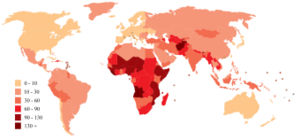
Demographics of Africa
Did you know...
The articles in this Schools selection have been arranged by curriculum topic thanks to SOS Children volunteers. Sponsoring children helps children in the developing world to learn too.
The population of Africa has grown exponentially over the past century, and consequently shows a large youth bulge, further reinforced by a low life expectancy of below 50 years in most African countries.
The total population of Africa is estimated at 922 million (as of 2005). It has doubled over the past 28 years, and has quadrupled over the past 55 years (UN estimates ). Population is projected to reach one billion before 2010. The most populous African country is Nigeria with 133 million (as of 2006), followed by Egypt (79 million) and Ethiopia (77 million).
Liberia, Burundi, Uganda, the Democratic Republic of the Congo, Madagascar and Burkina Faso have annual population growth rates above 3%.
34 out of 53 African countries are counted among the world's " Least Developed Countries".
Sub-Saharan Africa

More than 40% of the population of are below 15 years in most sub-Saharan countries, as well as the Sudan but with the exception of South Africa,, in Uganda as many as 50% (as compared to 20% in the USA). Infant mortality is high, with as many as 190 deaths per 1,000 live births in Angola, and between 25% and 50% malnourished in Tanzania, Kenya, Sudan, Mozambique, Madagascar, Zimbabwe, Zambia, Angola and other countries.
HIV/AIDS is widespread in sub-Saharan Africa, with some 11% of adult population infected and an estimated 2 million deaths caused by AIDS in 2005.
-
Life expectancy has fallen drastically in Southern Africa since the 1990s as a result of HIV.
Ethnicity
Speakers of Bantu languages (part of the Niger-Congo family) are the majority in southern, central and east Africa proper. But there are also several Nilotic groups in East Africa, and a few remaining indigenous Khoisan (' San' or ' Bushmen') and Pygmy peoples in southern and central Africa, respectively. Bantu-speaking Africans also predominate in Gabon and Equatorial Guinea, and are found in parts of southern Cameroon and southern Somalia. In the Kalahari Desert of Southern Africa, the distinct people known as the Bushmen (also "San", closely related to, but distinct from " Hottentots") have long been present. The San are physically distinct from other Africans and are the indigenous people of southern Africa. Pygmies are the pre-Bantu indigenous peoples of central Africa.
South Africa has the largest populations of whites, Indians and Coloured in Africa. The term " Coloured" is used to describe persons of mixed race in South Africa and Namibia. People of European descent in South Africa include the Afrikaner and a sizeable populations of Anglo-Africans and Portuguese Africans. Madagascar's population is predominantly of mixed Austronesian ( Pacific Islander) and African origin. The area of southern Sudan is inhabited by Nilotic people, the tallest and blackest people in the world.
List of major languages of Sub-Saharan Africa by region, family and total number of native speakers in millions)
- East Africa
- Afro-Asiatic
- Amharic: 35-42
- Somali: 15
- Oromo: 30-35
- Niger-Congo, Narrow Bantu:
- Swahili: 5-10
- Chichewa: 9
- Gikuyu (Kenya): 5
- Luhya: 4
- West Africa
- Niger-Congo
- Volta-Congo
- Benue-Congo
- Yoruba: 25
- Ibibio (Nigeria): 8-12
- Igbo (Nigeria): 10-16
- Akan (Ghana): 9
- More: 5
- Benue-Congo
- Fula-Wolof
- Fula (West Africa): 10-16
- Wolof: 3
- Volta-Congo
- Afro-Asiatic
- Hausa: 24
- Nilo-Saharan
- Kanuri: 4
- Southern Africa
- Niger-Congo, Narrow Bantu
- Zulu: 10
- Xhosa: 8
- Shona: 7
- Sotho: 5
- Tswana: 4
- Umbundu (Angola): 4
- Northern Sotho: 4
- Afrikaans: 6-7
- Central Africa
- Niger-Congo, Narrow Bantu
- Kinyarwanda (Rwanda) 7
- Kongo: 7
- Tshiluba: 6
- Kirundi: 5
North Africa
The peoples of North Africa comprise two main groups; Berber and Arabic-speaking peoples in the west, and Egyptians in the east. The Arabs who arrived in the seventh century introduced the Arabic language and Islam to North Africa. The Semitic Phoenicians, the European Greeks, Romans, Vandals and Pied-noir settled in North Africa as well. Berbers still make up the majority in Morocco, while they are a significant minority within Algeria. They are also present in Tunisia and Libya. The Tuareg and other often-nomadic peoples are the principal inhabitants of the Saharan interior of North Africa. Nubians are a Nilo-Saharan-speaking group (though many also speak Arabic), who developed an ancient civilisation in northeast Africa.
During the past century or so, small but economically important colonies of Lebanese, Indians and Chinese have also developed in the larger coastal cities of West and East Africa, respectively.
Some Ethiopian and Eritrean groups (like the Amhara and Tigrayans, collectively known as " Habesha") speak Semitic languages. The Oromo and Somali peoples speak Cushitic languages, but some Somali clans trace their founding to legendary Arab founders. Sudan and Mauritania are divided between a mostly Arabized north and a native African south (although the "Arabs" of Sudan clearly have a predominantly native African ancestry themselves). Some areas of East Africa, particularly the island of Zanzibar and the Kenyan island of Lamu, received Arab Muslim and Southwest Asian settlers and merchants throughout the Middle Ages and in antiquity.







